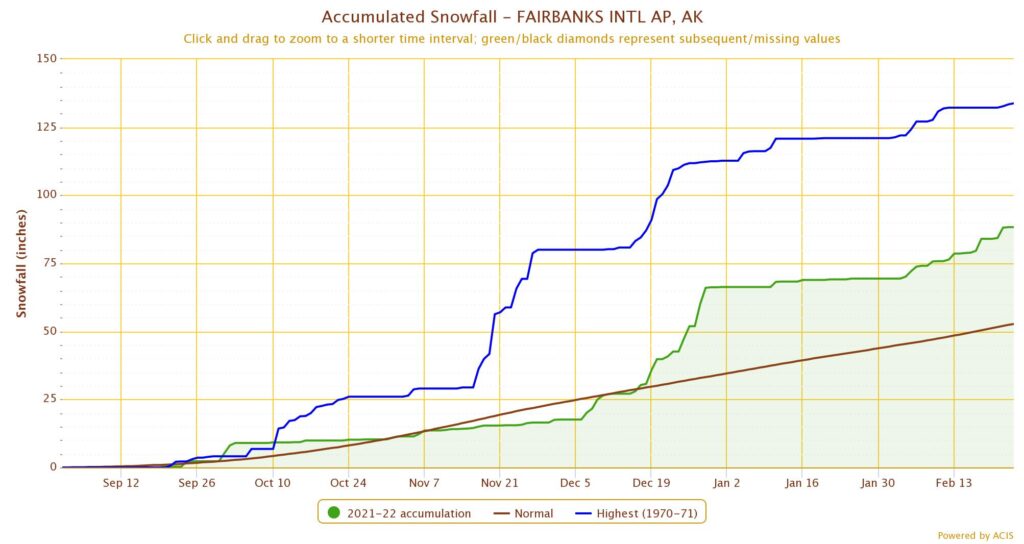We draw particular cautious attention to our reliance on the MERRA-2 model-based reconstructions for a number of important data series. ","grid_layout":"1","site_url":"https:\/\/akclimate.org","show_comments":"Show Comments","masonryEnabled":"","blogMasonryBreakPoint":"768"}; dataType: "script",
"That results in a 177% of average to date and a 170% of the April 1 .
The month with the highest number of snowfall days is December (11.6 days). [7][failed verification], On March 17, 2002, there was a storm that caused 28.6 in of snow to close schools for two days. The charts include values for the 2021-2022 season through February 24, as well as the long-term average and the season with the highest recorded values at each location. // Allow user to set any option except for dataType, cache, and url. The US average is 38 inches of rain per year. For print usage, please acquire a license. Detailed climate information with charts - average monthly weather with temperature, pressure, humidity, precipitation, wind, daylight, sunshine, visibility, and UV index data. For most of winter, Anchorage has at least five inches of snow on the ground. return jQuery.ajax( options );
 For reference, on June 19, the muggiest day of the year, there are muggy conditions 0% of the time, while on January 1, the least muggy day of the year, there are muggy conditions 0% of the time. Because of Anchorage's high latitude, summer days are very long and winter daylight hours are very short.
For reference, on June 19, the muggiest day of the year, there are muggy conditions 0% of the time, while on January 1, the least muggy day of the year, there are muggy conditions 0% of the time. Because of Anchorage's high latitude, summer days are very long and winter daylight hours are very short.
$( document ).tooltip({
 For reference, on June 19, the muggiest day of the year, there are muggy conditions 0% of the time, while on January 1, the least muggy day of the year, there are muggy conditions 0% of the time. Because of Anchorage's high latitude, summer days are very long and winter daylight hours are very short.
For reference, on June 19, the muggiest day of the year, there are muggy conditions 0% of the time, while on January 1, the least muggy day of the year, there are muggy conditions 0% of the time. Because of Anchorage's high latitude, summer days are very long and winter daylight hours are very short. For reference, on July 20, the hottest day of the year, temperatures in Anchorage typically range from 55F to 68F, while on January 17, the coldest day of the year, they range from 13F to 23F. These snow records are reviewed yearly and updated as new data is recorded. anchorage average snowfall by month 3- Classes pack for $45 anchorage average snowfall by month for new clients only. . For snow and ice contractors, the winter is typically judged by how much money made it into the bank.
}else{
On this Wikipedia the language links are at the top of the page across from the article title. The months with the highest UV index are June and July (UV index 4).  (1937)
(1937)  [2] The weather on any given day is very unpredictable. Climate Normals. Average daytime summer temperatures range from approximately 55 to 78F (12.8 to 25.6C); average daytime winter temperatures are about 5 to 30F (15.0 to 1.1C). Snowstorms of over five inches a day normally occur three or four times a year. The highest chance of overcast or mostly cloudy conditions is 63% on December 18. One of the major goals of the climate action plan is to reduce green house gas emissions by 80% by the year 2050 from its 2008 emission levels. Sorry, the location you searched for was not found.
[2] The weather on any given day is very unpredictable. Climate Normals. Average daytime summer temperatures range from approximately 55 to 78F (12.8 to 25.6C); average daytime winter temperatures are about 5 to 30F (15.0 to 1.1C). Snowstorms of over five inches a day normally occur three or four times a year. The highest chance of overcast or mostly cloudy conditions is 63% on December 18. One of the major goals of the climate action plan is to reduce green house gas emissions by 80% by the year 2050 from its 2008 emission levels. Sorry, the location you searched for was not found.